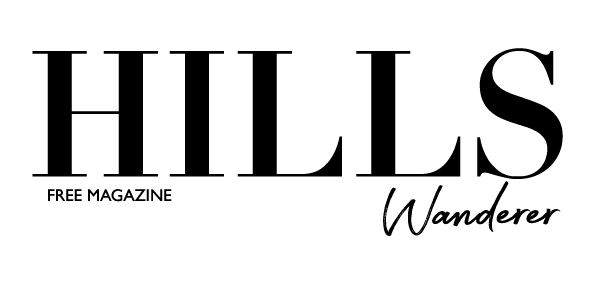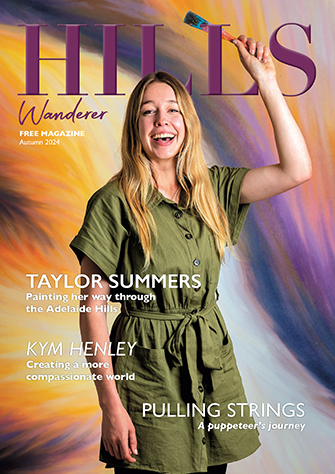For Aboriginal artist David Booth, nothing matters much except culture, connection and family.
Whether it be painting large murals at primary schools and public spaces across the Adelaide Hills, or performing traditional dance at events, sharing culture and connection is something he says he’ll do until the end.
David’s passion for expressing his Aboriginal heritage, he says, was born from his mother’s determination to do the same – to keep connection alive and share the importance of culture and family.
“As kids, Mum was always engaging us with culture, surrounding us and connecting us with cultural Elders, teachers and knowledge holders,” he says.
“She was an amazing person, the strongest I’ve met in my life, and I think that made a real impression on me, being proud of who we are.
“Now I’m sharing that knowledge with my kids, making them stronger and understanding their connection to culture, family, country, and the environment.
“Family has always been number one. Mum made that impression on us and those values have been instilled in me.”
Born on Yuggera country in Brisbane, David grew up being home-schooled on the road with his mother Jeannette, brothers Joshua, Luke and Matthew, and sisters Sarah and Rebecca, travelling around the country’s central corridor.
David’s mother, a member of the Stolen Generation, experienced a tough upbringing and longed to reconnect with her cultural roots.
“My mum didn’t have a good start in life or a strong connection with culture, being removed at five years old, so she was looking to find that connection,” he says.
“I think we, as siblings, were along for the ride with Mum. We loved being on the road. It was fun every day, somewhere different and something new.”
Forming an Indigenous arts and cultural business called Waltjapiti, which means family, the Booths would often engage with local Indigenous leaders Amos Roach and Ngarrindjerri elder Uncle Major ‘Moogy’ Sumner to share songs, stories and dance.
The Booth family shared their learnings up through the Northern Territory, touring communities and exchanging knowledge with other Aboriginal people across the region.
By his teenage years, David and his family had settled in Adelaide where he attended Croydon High School.
By the age of 18, David and his siblings formed their own youth dance group, Imbala Jarjum, meaning butterfly children.
Their connection with Peramangk country began when meeting a Peramangk Elder from the Hunter family, researching language and recreating a dance for Peramangk people.
Their connection to the Adelaide Hills was strengthened when the family bought an Indigenous art gallery in Hahndorf’s main street, and continued to share dance, music, art and stories, helping visitors to the town celebrate one of the oldest cultures in the world.

David, a player of the yidaki (didgeridoo), hosted events and talks.
But in 2013 the financial pressure of sustaining the business became too much and the family gave up the venture, heading back to the Northern Territory and Queensland.
“The business side of things was really draining on our cultural energy, our entity and connection to culture,” David says.
“It really took away from why we went into business in the first place – which was to connect to culture and to be Aboriginal owned and operated so that we could help other Indigenous people in arts and cultural tourism.
“That’s why we decided to close it down and head back to country.”
In 2014, tragedy struck when David’s brother Joshua passed away unexpectedly.
The impact on David was enormous and he saw no option other than to return to Queensland to be with family and find some healing.
“I was struggling to find a place where I felt the same as when my brother was alive and the family was together,” he says.
“The only way I could figure out how to do that was to escape and be out in the country, back up in the Territory.
“The only time I ever felt normal was when I was on the road travelling. As a kid I was always out bush, I was free. I didn’t have a watch, I didn’t have a phone. You wake up with the sun and you go down with the sun. It was that freedom I was looking for so I did that for a while and found some healing.
“I came back to Adelaide, and that’s when I started painting.”
David’s paintings, jewellery and other artefacts began selling at local markets, stalls and galleries as he realised his talent for art.
But a few months after returning to Adelaide, family tragedy struck again when his mother was diagnosed with cancer.
David fled to be with her in Queensland, spending the next four months “watching her fade away” before she died.
Despite the heartache, David has turned his grief into a determination to keep sharing the importance of family, community and country, as his mother would have wanted.
He worked for an Aboriginal art gallery in the Adelaide Hills and continued selling his wares before realising he could make a living from his creations. David was also hosting cultural, dance and music workshops in the region and it wasn’t long before he was commissioned to create his first public mural, which turned into another.
Now David’s Aboriginal art murals can be spotted at schools and public places across the Adelaide Hills including Crafers, Mt Pleasant, Mt Barker South, Basket Range, Arbury Park and Hills Montessori School primary schools, as well as Mt Barker High School and St Francis de Sales College.
Other murals can be spotted at Miels Park in Littlehampton and the Summit Sports Centre in Mt Barker.
David has also designed Indigenous round uniforms for local football and netball clubs.
School students and community members have assisted in creating some of the murals, helping grow cultural awareness.
“I work with groups of students who are Indigenous and non-Indigenous so they can understand culture and become stronger role models within their community as they grow into adulthood,” he says.
“That’s the whole aim of why I’m doing this, it’s my passion. It’s something I see myself doing for the rest of my life.”




